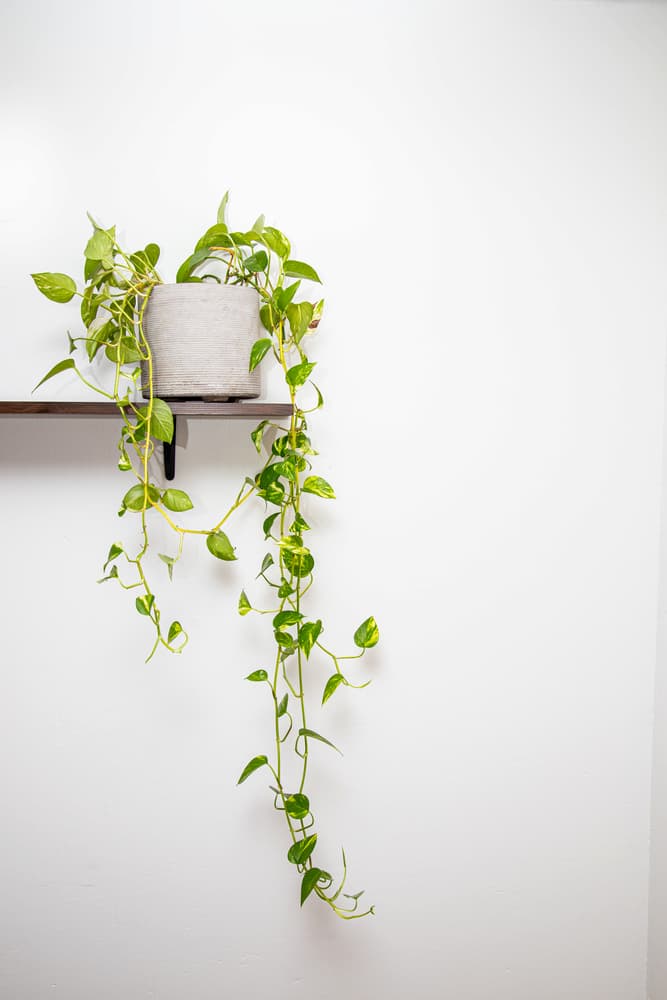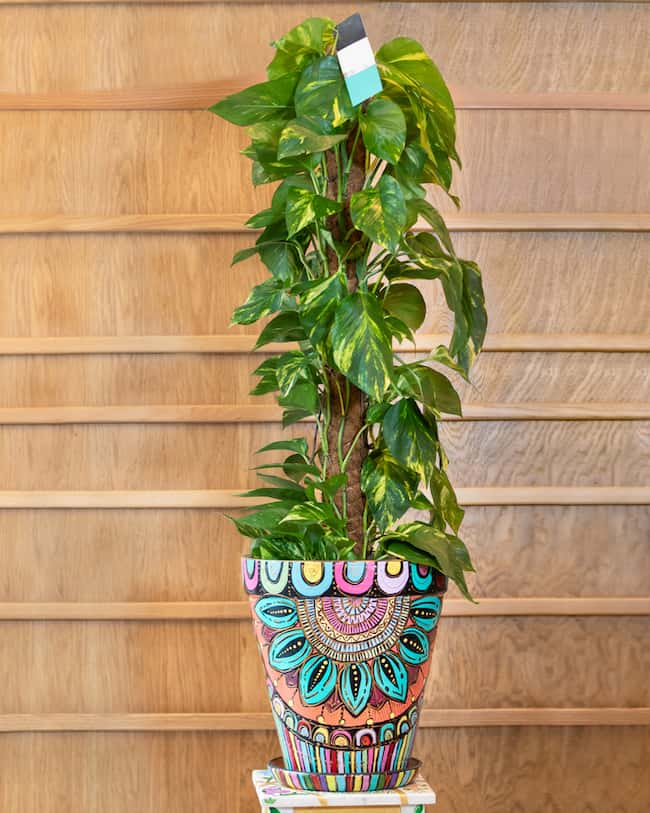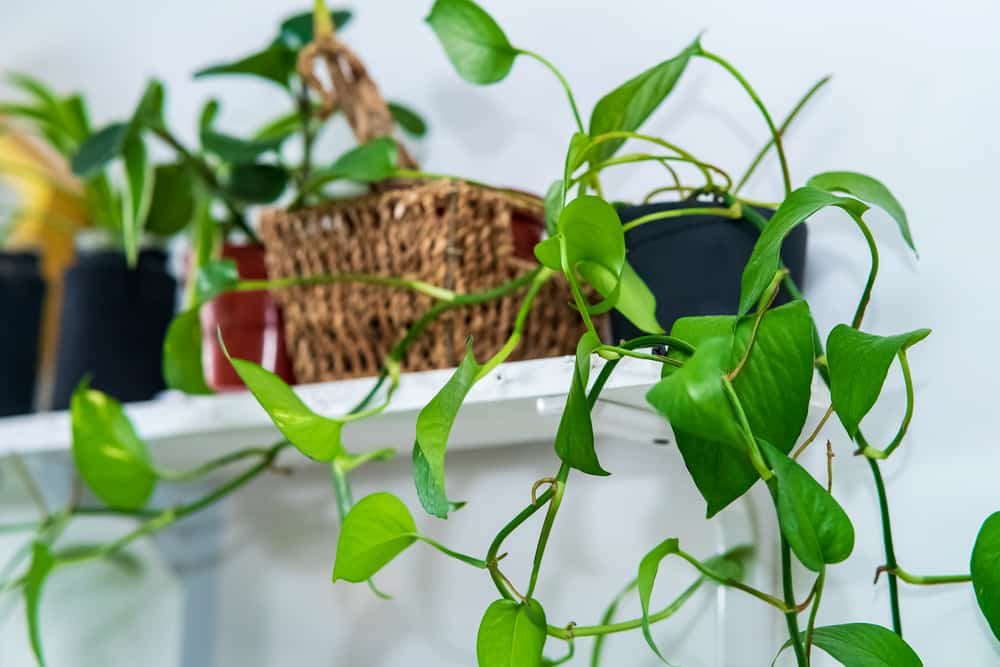Having a trailing pothos in any room is a great way to brighten up your home. It’s also very easy to care for, making it a great choice for those who are new to gardening.
In this article, we will discuss the best way to care for trailing pothos plants and provide some tips on how to make them look their best!

Table of Contents
Do pothos like to trail?
Yes, trailing pothos plants do like to trail! They are known for their long, cascading vines that can reach up to several feet in length. When growing trailing pothos, you will need to provide them with a support structure so that they can climb and trail as they grow.
This can be anything from a trellis to a moss pole or a wire mesh. Just make sure that the structure is sturdy enough to support the plant’s growth and is long enough to allow the vines to trail down.
Find out more: How to Put a Pothos on a Moss Pole (So It Thrives)
You can also trail a pothos by wrapping it around a support such as a curtain rod or shelf. Nails can easily be added to a wall to further trail the plant, as long as you’re careful not to damage the vine by piercing through it. This is a great way to add some greenery in your home without taking up too much space.
Trailing pothos plants are known for being very easy to care for. They are tolerant of a wide range of growing conditions and can even survive in low-light areas, so you can trail them in the living room, kitchen, bedroom, or the bathroom.
They also don’t require a lot of maintenance, so you can sit back and enjoy their beauty without having to worry about them too much. This is a great beginner’s vine, since other trailing plants can be much more finicky and require more care.
Should I let my pothos hang?
Pothos plants make beautiful and easily maintainable hanging plants. Since they naturally vine over time, you can simply place them in a higher spot in your home and let them cascade over the sides of the pot and down. This allows you to get a unique look without having to do much work.
To let your pothos plant hang, you’ll need to choose a pot that is slightly larger than the one you would normally use. This is because the roots will need room to spread out as they grow and support the plant’s weight. You can also use a hanging basket, which will give the plant even more room to spread out.
Once you’ve chosen a pot, simply fill it with a well-draining potting mix and water it thoroughly. Then, place the plant in a location where it can get bright, indirect light and allow the vines to trail over the sides of the pot.

If you don’t have a hanging basket to use, you can still let your pothos plant trail down. Simply place the pot on a higher surface, such as a shelf or table, and allow the vines to cascade over the edge.
Make sure to regularly detangle your hanging pothos plant to prevent the vines from getting too tangled. You can do this by gently pulling the vines apart and re-wrapping them around the support structure. Be careful not to damage the vines while you’re doing this.
Trailing pothos care: key points
When you’re caring for trailing pothos plants, there are a few key points to keep in mind:
1. Use a support
Trailing pothos plants like to climb and trail, so you will need to provide them with a support structure. This can be virtually anything you have lying around or a specific support meant for plants.
In order to grow the pothos onto the support, you can either plant it near the base of the structure or train it to climb by wrapping the vine around the support.
Find out more: 9 Simple Steps to Train Your Pothos to Climb
2. Choose a pot
When choosing a pot for your trailing pothos, make sure to choose one that is slightly larger than you would normally use. This means you won’t have to repot the pothos plant as often and the roots will have plenty of room to spread out. You can also use a hanging basket for an even more dramatic effect.

3. Be careful not to overwater the plant
One of the most common problems with trailing pothos plants is overwatering. Make sure to only water your pothos when the soil is dry to the touch and never allow the plant to sit in water. This will keep your stems and leaves strong and healthy.
4. Regularly train and detangle the plant
Since trailing pothos plants like to climb and trail, you will need to regularly train them onto their support structure.
You can do this by gently wrapping the vine around the support. You should also regularly detangle the plant to prevent the vines from getting too tangled.

5. Place in a bright, indirect location
Trailing pothos plants do best in bright, indirect light. This means they should be placed near a window but not in direct sunlight. Direct sunlight can scorch the leaves and damage the plant.
6. Make sure the vines are high enough
You don’t want the vines of your trailing pothos plant to trail too low. If they do, they can become damaged or even die.
Make sure the plant is placed high enough to avoid children, pets, or anything else that could come into contact with them.

Why is my pothos not trailing?
Not enough water or light is usually the main cause of pothos not trailing. Make sure to water the plant when the soil is dry and place it in a bright, indirect location. If you’re still having trouble, you can try fertilizing the plant or repotting it into a larger pot.
Another possibility is that your pothos plant has a more serious issue such as a disease or pest infestation. If you suspect this is the case, take a closer look at the plant and see if there are any signs of pests or diseases. If you find anything, you can try treating the plant with a pesticide or fungicide.
Some common pests that can affect pothos plants include aphids, mealybugs, spider mites, and whiteflies. These pests can cause the leaves of the plant to yellow or discolor. They can also lead to stunted growth or even death.

You should also make sure that your plant is receiving enough nutrients. A lack of nutrients can slow down the plant’s growth and eventually change the color of the leaves. If you think your plant isn’t getting enough nutrients, you can try fertilizing your pothos with a balanced fertilizer or using more nutrient-dense soil.
Best soil for Pothos
Miracle-Gro Tropical Potting Mix
Light and well-draining (perfect for avoiding root rot) while being packed with just the right nutrients – that will feed your plant for up to six months. The best soil for keeping your pothos healthy and strong.
Finally, checking the health of the roots is also important. If the roots are damaged, it can affect the plant’s ability to take up water and nutrients. The roots may be sitting in water, or they may not have enough room in the container, and both problems will require you to repot the plant.
How long will it take my pothos to trail?
Your pothos plant should start to trail two or three months after you have introduced it to a support. In nature, the pothos plant is a pro at trailing, so it won’t take long for your plant to catch on indoors if it is healthy and well taken care of.
The growth rate of a pothos plant during the active season is about six to twelve inches a month. However, the plant will grow more slowly during the winter months, so don’t expect too much growth during this time.
By five or six months, with proper care, you can expect your plant to be up to 60 inches long. This means it will have been able to trail over a shelf, doorway, or any other support you have given it.
By the end of a year of trailing, you can expect your pothos plant to be up to 3 to 10 feet long, depending on the size and health of the pothos plant you started with. This makes the pothos plant one of the easiest and quickest plants to trail indoors.
Related: How Fast Does Pothos Grow (and How to Make it Grow Faster)?
How to make my pothos trail faster?
One great way to make your pothos plant trail faster is ensuring it’s receiving enough water. The soil should be moist but not wet. Water the plant when the top inch of soil is dry. Also ensure the plant is getting enough sunlight. This is the fuel and food of the plant and determines its growth rate.
A good watering schedule consists of watering your plant once every week or two and is determined by the moisture of the soil. If you live in a hot and dry climate, you will need to water your plant more often. If you live in a cooler and wetter climate, you can water your plant less often.

Just make sure not to overwater your pothos, which is one of the main reasons it might not be trailing. Too much water can lead to the roots rotting, which will stunt the plant’s growth.
Using high-quality soil and fertilizing your plant will also help to speed up its growth. Fertilize your plant with a pothos or all-purpose blend and make sure to follow the instructions on the package. As tempting as it may be, avoid fertilizing your plant in the dormant winter months because it could actually harm your pothos.
Best fertilizer for Pothos
Jack’s Classic 20-20-20 All Purpose Fertilizer
A great fertilizer with the perfect balance for your pothos. Simply dissolve in water and feed your plant to watch it thrive.
Does pruning pothos help it grow faster?
Yes, regularly pruning your pothos can help to encourage new growth, which will make the plant grow faster. You can prune your pothos about once a month and make sure to use sharp and clean shears or scissors. Cut off any yellow, brown, or dead leaves to help redirect energy to new healthy growth.
Never cut off more than a third of the plant at one time because this can shock the plant and damage it. Start by pruning back any long vines, then cut off any leaves that are discolored or dead. Once you have removed all of the damaged growth, you can shape the plant however you like.
Pruning your pothos will also help to keep the plant from getting too leggy. If the plant is not receiving enough light, it will start to stretch out and become thin in an attempt to reach the light source. This is why pruning back the plant can help it to grow faster because it will encourage new growth that is fuller and healthier.
What types of pothos trail the fastest?
There are many different types of pothos plants, but some varieties are known to trail faster than others. The Jade pothos and golden pothos are two of the fastest-trailing varieties because they are full of chlorophyll which helps the plant to produce energy and grow quickly.
Slower growing pothos plants include heavily variegated varieties. A variegated pothos has leaves that are two or more colors. These plants have less chlorophyll because the variegation are white and cannot metabolize sunlight, which means they won’t grow as quickly as plants with solid green leaves.
Slow-growing pothos varieties include the n-joy pothos and the marble queen pothos, which have variegated leaves that leave them being as mostly white pothos varieties. These plants can still trail beautifully, but they might not grow as quickly as some of the other varieties.
Related: Jade Pothos Care: The Ultimate Guide
When should I start trailing my pothos plant?
The best time of the year to start trailing your pothos plant is in the springtime. This is when the plant will start to actively grow and produce new leaves and vines. If you live in a climate with mild winters, you can start trailing your pothos plant any time of year.
If you just brought your pothos plant home and plan to transfer it into a new pot or hanging basket, keep in mind that it will initially experience a mild or moderate amount of stress. This is perfectly normal and the plant will start to produce new growth once it has acclimated to its new environment.

To help your plant transition smoothly, make sure to water it regularly and give it plenty of bright, indirect light. Avoid fertilizing your plant for the first few weeks after transplanting because this can further stress the plant. Once the plant has settled in, you can start fertilizing it on a regular basis to help encourage new growth.
What do you do with trailing pothos?
There are many different ways that you can use trailing pothos in your home or office. You can trail it along a shelf, doorway, or windowsill. You can also let it spill out of a hanging basket or cascade down from a high point. Many supports allow for easy displays of trailing plants.
You can choose how to direct and train your pothos along the way, or allow for more organic growth. Just be careful and make sure that the pothos plant does not get too long or become overgrown. If this happens, you can always prune the plant back to encourage new growth.
It’s possible that your pothos vine may intertwine with other houseplants if it’s not given enough space to trail. Pothos are known for being very versatile and adaptive plants, so they can often tolerate a bit of crowding. However, if the plant becomes too crowded it will start to produce smaller leaves and stems.
If you want your pothos plant to have more of a cascading effect, you can let it trail down from a high point. This is a great way to show off the plant’s long vines, and you can even add some extra interest by including other plants or objects in the display.
How do you pin pothos to the wall?
To pin your pothos plant to the wall, using Command Clear Mini Hooks is a great option. These provide plenty of support for your pothos without damaging the plant, wall, or leaving behind any residue. They are also clear, so you will have a clean and minimalistic look.
Start by attaching the mini hooks to the wall in a row at the desired height. Then, take your pothos plant and place it next to the wall. Using a thin wire or fishing line, start at the bottom of the plant and secure it to the first hook. Work your way up the plant, attaching the wire or fishing line to each hook as you go.
Another option is to use push pins or thumb tacks. These can be placed directly into the wall and will provide support for your plant. Be sure to be gentle with the plant and avoid pushing the pins or tacks in too deeply, as this could damage the plant.
If you want to create a more permanent display, you can use screws or nails to attach a wire or trellis to the wall. This will provide support for your pothos plant and allow it to get as full and heavy as possible without falling down.


